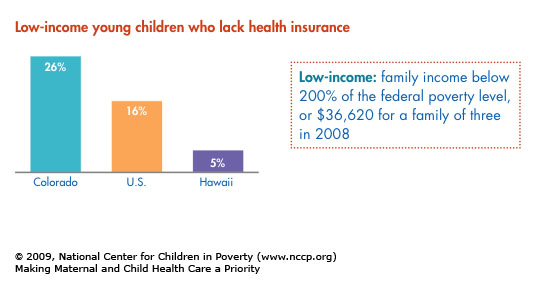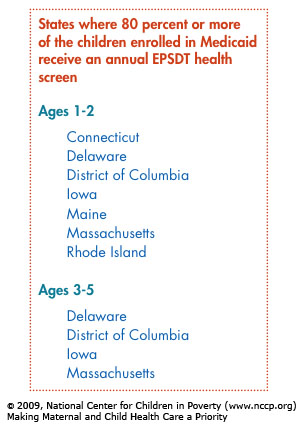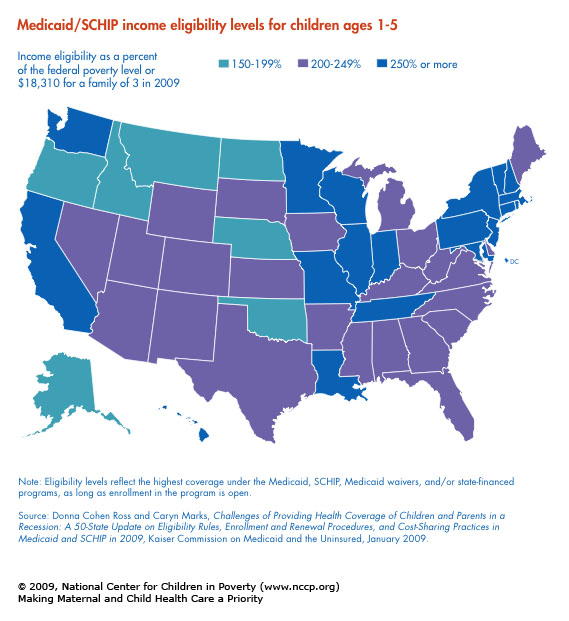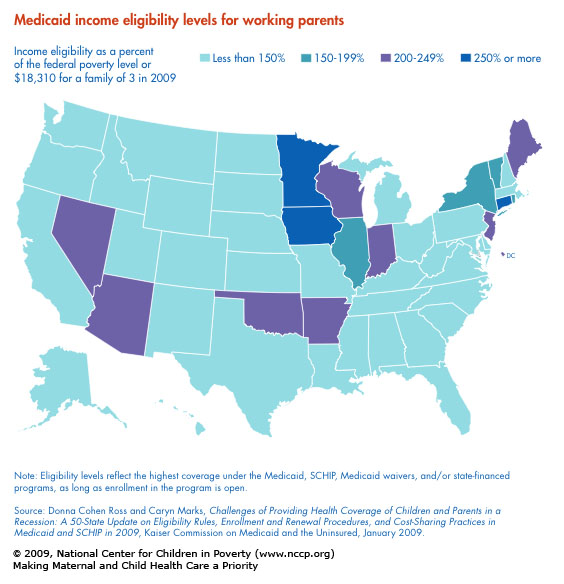Learn about our Improving the Odds for Young Children project.
As the national debate about health care continues, two things remain clear about ensuring children’s health:
- Access to health insurance is not enough. While eligibility for and enrollment in Medicaid and/or SCHIP is fundamental, children must get to the doctor at regular intervals for the screening, diagnosis, and treatment of any special needs or developmental delays they have, coupled with follow-up referrals to needed services to address them.
- Healthy children need healthy parents. The health of the mother – before, during, and after pregnancy – has a direct impact on the health of the child.
To help inform the national and state-level debate on how to improve the health care system, this fact sheet takes a closer look at state policy choices that promote access to high-quality health care for mothers and children.
What the Research Says About…
…Early Childhood Health
Improving access to high quality health care improves health and developmental outcomes, especially when targeted to low- income and minority children. Basic health services – including oral health, and vision and hearing screening and treatment – are essential to healthy child development. Improving access to health services, including mental health care when needed, is one of the most effective policies available for reducing early childhood health impairments.
…Maternal Health
Biological and neurological sciences show that the predictors of healthy child development begin before pregnancy, with the health of the mother, and continue after the birth, with the mother-child relationship. Smoking, substance abuse, poor nutrition, maternal depression, and perinatal infections in mothers can harm babies before birth; and postpartum, can lead to low birth-weight, respiratory problems, chronic disease, and even infant death. Economic insecurity also increases maternal stress and impacts both healthy births and healthy child development. Young children who grow up with parents who have mental health problems face significant threats to their own emotional development, and in extreme cases, it threatens the developing brain of the child. To access high quality health care, parents need health insurance that covers both physical and mental health, and practitioners who can provide accurate diagnoses and referral.
The Current Landscape

Unfortunately, those who need high quality health care most are least likely to receive it.

Low-income young children are more likely to be uninsured.
- Sixteen percent of low-income young children are uninsured, compared to 11% of all young children. Uninsurance rates of low-income children range from a high of 26% in Colorado to a low of 5% in Hawaii.
In most states, low-income children and pregnant women have access to public health insurance (Medicaid/SCHIP) but parents do not.
- While 44 states set the income eligibility at or above 200 percent of the federal poverty level for young children, only 12 states cover parents at this same level. More than half of all states set income eligibility below the poverty level for working parents.
In most states, the enrollment and eligibility process for Medicaid and SCHIP can be time consuming. In some cases, the re-enrollment process results in eligible families losing coverage for administrative and paperwork reasons. Despite state efforts to streamline the process, there are times when eligible recipients need medical care before their application is approved.

- Thirty states have adopted “presumptive eligibility” policies that provide temporary coverage to pregnant women, but only 14 states have a similar policy for children.
- Eighteen states have established continuous eligibility provisions that ensure coverage for one year, without eligibility redeterminations, and several states have established stream- lined re-enrollment processes that have virtually eliminated gaps in coverage for administrative and paperwork reasons.

Even when children have health insurance, they are not getting the health and dental screenings that are consistent with pediatric practice and can prevent or reduce future problems. The Early and Periodic Screening, Diagnosis and Treatment (EPSDT) program is Medicaid’s comprehensive child health benefits package, which requires states to periodically screen children for good health, diagnose any illnesses or delays, and treat them. To encourage outreach to children who are eligible for Medicaid, the federal government sets a benchmark of 80 percent of enrolled children receiving at least one health screen each year.
- Only seven states report that more than 80 percent of 1- and 2-year-olds receive at least one screening. For children ages 3 to 5, only four states meet the 80 percent benchmark.
What States Can Do
Fully addressing the barriers that children and parents face in accessing health care requires action at the national and state level. But even without federal action, there are a number of important steps that states can take. These include:
- Set the income eligibility limit for children’s public health insurance (Medicaid/SCHIP) at or above 200 percent of the federal poverty level. It takes at least twice the poverty level for a family to ensure that young children have access to even basic necessities.
- Cover children and their parents. Healthy children need healthy parents.
- Provide temporary coverage to pregnant women and children under Medicaid until eligibility can be formally determined, and provide for continuous eligibility with streamlined reenrollment processes.
- Provide incentives and supports for pediatric health practitioners to conduct comprehensive well-child visits – including health, dental, and vision screenings – with referrals for needed follow- up services to address child developmental and behavioral issues, and parental depression concerns.
For more information on state policy choices to improve the odds for healthy early childhood development, see NCCP’s Improving the Odds for Young Children project.
The author thanks David Gottesman for his research assistance in writing this fact sheet.
Endnotes
1. Shone, L. P.; Dick, A. W.; Klein, J. D.; Zwanziger, J.; Szilagyi, P. G. 2005. Reduction in Racial and Ethnic Disparities After Enrollment in the State Children’s Health Insurance Program. Pediatrics 115(6): e697-e705.
2. Center on the Developing Child at Harvard University 2007. A Science-based Framework for Early Childhood Policy Using Evidence to Improve Outcomes for Learning, Behavior, and Health for Vulnerable Children.
3. Lu, M. C.; Halfon, N. 2003. Racial and Ethnic Disparities in Birth Outcomes: A Lifecourse Perspective. Maternal and Child Health Journal 7(1):13-30.
4. Children’s Emotional Development is Built Into the Architecture of Their Brains. 2004. National Scientific Council on the Developing Child, Working Paper No. 2.
5. State data were calculated from the Annual Social and Economic Supplement (March) of the Current Population Survey from 2006, 2007, and 2008, representing information from calendar years 2005, 2006, and 2007. NCCP averaged three years of data because of small sample sizes in less populated states. The national data were calculated from the 2008 data, representing information from the previous calendar year.
6. Ross, Donna Cohen; Caryn Marks. 2009. Challenges of Providing Health Coverage of Children and Parents in a Recession: A 50-State Update on Eligibility Rules, Enrollment and Renewal Procedures, and Cost-Sharing Practices in Medicaid and SCHIP in 2009. Kaiser Commission on Medicaid and the Uninsured.
9. U.S. Department of Health and Human Services, Centers for Medicare and Medicaid Services, EPSDT CMS-416 Data, FY 2007, updated July, 1, 2008.
10. Cauthen, Nancy; Sarah Fass. 2008. Measuring Poverty in the United States. National Center for Children in Poverty.
